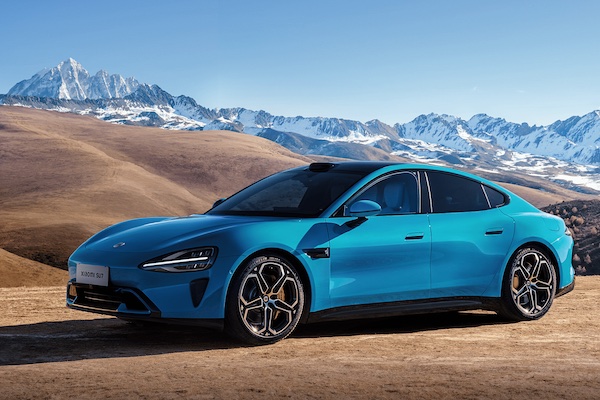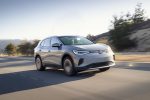
China new models April 2024: Xiaomi SU7 and Li L6 land
Xiaomi SU7
Let’s examine the newcomers in the Chinese wholesales charts for April. This month we have 12 new models hitting dealerships, 10 of them Chinese. I keep repeating this but once again this shows the extraordinary rate at which domestic manufacturers launch new models compared with foreign ones. To fully understand the scope of the Chinese market, make sure you consult our Exclusive Guide to all 184 active Chinese Brands.
1. Xiaomi SU7 (7,058 sales)
Easily the most anticipated model of 2023, the Xiaomi SU7 EV lands in the charts, already passing the 7,000 monthly wholesales threshold. The SU7 is phone maker Xiaomi’s first inroads in the automotive world and it sparked worldwide attention. The exterior design has been known for a while and is rather classic, with clean aerodynamic lines. The Auto Design consultant at Xiaomi is former BMW Group Chief of Design Chris Bangle and the the exterior designer is James Qiu, who joined Xiaomi from Mercedes-Benz. Xiaomi claims a drag coefficient of 0.195 Cd which is the lowest among production vehicles.
Inside, all materials are flawlessly smooth, the dashboard is understated with few commands on the steering wheel and the gear shift as a wand behind the wheel. The central touch screen on the large end (16.1-inch) but Xiaomi didn’t fall victim of the end-to-end screens we have now been accustomed to with Chinese carmakers. Refreshingly, there are still some physical buttons below the screen and on the central command. There’s even a screen on the back of the driver’s seat to occupy the kids during long trips. Other features include a 4.7 litres fridge which can fit 6 cans and multiple storage compartments for laptops and smartphones.
The top variant, the SU7 Max Performance, eclipses the 0-100 km/h in just 2.78 seconds and has a top speed of 265 km/h. It managed to complete a lap of the Zhejiang Car Race, an FIA-approved Grade 2 circuit, in 1 minute 38.043 seconds, which is faster than the Porsche Taycan Turbo S and the Tesla Model S Plaid, against which the car was benchmarked. It rivals the Lotus Eletre R+. Its range is 800 km CLTC and it can charge 510 km worth of its 101 kWh CATL Qilin battery in 15 minutes. The SU7 is an AWD with dual motors for a 664 hp output.
The SU7 is manufactured under contract by BAIC Off-road in Beijing. Lei Jun, Xiaomi’s CEO, announced some sales results at the Beijing Auto Show. Sales of the SU7 have been 3-5 times higher than expected. The brand has received lock-in orders (non-refundable deposits) for a staggering 75,723 units. On 29 April the 10,000th SU7 rolled off the factory, which is in line with this month’s wholesales result. It aims to increase its presence to 46 cities with 219 stores and 86 cities with 143 service points by the end of 2024. The SU7 is priced from 215,900 to 299,900 yuan (28,000-38,900€ or US$30,400-42,300) and will compete with the likes of the Tesla Model 3 (231,900-335,900 yuan), BYD Han (169,800-299,800 yuan), Zeekr 007 (209,900-299,900 yuan) and IM L6 (219,900-345,900 yuan). It looks assured to be a roaring success and will likely surpass its bar for success as early as May or at the latest in June.
Bar for success: 10,000 monthly sales
2. Changan UNI-Z (4,165 sales)
The Changan UNI-Z is a 5-seater mid-size 4.73m long crossover SUV originally known as the COS aka Oshan Z6. The Z6 launched in March 2022, and the UNI-Z PHEV, unveiled in March 2024, is simply a rebadged and facelifted Oshan Z6 which it will replace. It is the fourth model in the UNI new energy series. The interior features a 10.25-inch instrument panel and a 14.6-inch infotainment central screen. On-board tech includes Huawei HiCar, Amap from Alibaba, a Sony audio system and facial and voice recognition. Performance-wise, the UNI-Z achieves the 0 to 100 km/h in 7.4 seconds and its top speed is 180 km/h. It has a 18.4 kWh lithium iron phosphate battery back with a 125 km CLTC range.
Originally announced at a price range of 127,900 to 134,900 yuan which was already very aggressive, Its final price is even lower: from 117,900 to 131,900 yuan (15,300-17,100€ or US$16,600-18,600). This has become common in the current price war occurring in the Chinese market. The UNI-Z will compete with the BYD Song Pro (109,800-159,800 yuan). Note the COS Z6 was priced significantly higher at 155,800 to 175,800 yuan. The UNI series has been a successful venture for Changan, with the UNI-V hitting a record of 17,372 units last January. As for the COS Z6 is reached a 16,128 also last January. The UNI-Z has already managed a relatively solid start at over 4,000 wholesales and would need to deliver double this amount to be deemed a success.
Bar for success: 8,000 monthly sales
3. Jetour Shanhai T2 (2,746 sales)
Jetour is on a roll at the moment with wholesales up 127.2% year-on-year over the first 4 months of 2024. Note Jetour (+137.1%) outsold Haval (-40.3%) in April, a significant achievement. The Shanhai T2 is yet another boxy SUV with a boxy shape inspired by the Land Rover Defender that have proliferated recently. It is the second model in the New Energy Shanhai (“mountain sea”) series after the L9. The Shanhai T2 is in fact the PHEV variant of the Traveller SUV (confusing!). It’s an off-road SUV with an approach angle of 28°, a departure angle of 30°, 205 mm ground clearance and 700 mm wading depth.
The Shanhai T2 uses Chery’s Kunpeng Super Hybrid C-DM system with a 3-speed dedicated hybrid transmission. The interior is the same as the Haval Traveller with a 10.25-inch instrument panel and a 15.6-inch infotainment screen. It is priced from 179,900 to 209,900 yuan (23,300-27,200€ or US$25,400-29,600). For reference the Traveller’s price range is 139,900-219,900 yuan. The T2 will compete with the likes of the similarly boxy Haval Raptor New Energy (165,800-192,800 yuan) and the BYD Tang New Energy (179,800-269,800 yuan). The Traveller has become by far the best-selling Jetour model with 10,049 units in April. The Shanhai T2 will likely sell less but still has strong potential.
Bar for success: 4,000 monthly sales
4. Li L6 (2,381 sales)
With a bunch of lookalikes, One then L9 (September 2022), L8 (November 2022) and L7 (March 2023) up until the arrival of the Mega MPV in March, Li Auto has managed to find itself a regular spot inside the Chinese Top 20 brands: it finished 2023 at #17. In the space of just a few of years it has become a strong player in the Chinese market. It is the first Li model under 5m long at 4,925m. Even though it is categorised as a compact crossover SUV, the maximum second-row legroom is 1,135m. Like its fellow L-series members, the The L6 is an Extended range EV with dual electric motors. The 1.5T four-cylinder ICE only here to charge an electric generator that charges the vehicle’s battery, it is not connected to the wheels. The pure electric range is 212 km and the comprehensive range is 1,390 km.
The exterior design is once again almost identical to the L7, L8 and L9 which is a little disappointing. Inside the cockpit we have the usual double giant 15.7-inch screens: the central console and the passenger entertainment unit. As the cheapest Li model, the L6 has even greater potential. For reference it is priced from 249,800 to 279,800 yuan (32,400-36,300€ or US$35,200-39,500) vs. 301,800-359,800 yuan for the L7, 321,800-379,800 yuan for the L8 and 409,800-439,800 yuan for the L9. The L6 has competitors that include both the Aito M5 (249,800-309,800 yuan) and Aito M7 (249,800-329,800 yuan). Li models have had great success so far, all hitting their record volumes last December: the L7 at 20,428, the L8 at 15,013 and the L9 at 14,913. These are all fantastic results for the price range. We’d want to say the L6 may even exceed these numbers so the bar for success is achievable.
Bar for success: 8,000 monthly sales
5. Neta L (1,768 sales)
New Energy manufacturer Neta is struggling mightily so far in 2024 with wholesales down a daunting -42.8% over the first 4 months of 2023. So the brand needs all the fresh blood it can muster, and this new addition, the L, has a lot riding on it. It is a medium-size SUV at 4,77m long. The exterior design is nothing exceptional and will struggle to stand out in the segment, one good point though is the hidden door handles. It’s the cockpit that impresses the most with two 15.6-inch screens, one for the central console and one for the passenger entertainment. It also sports a 6.6L refrigerator and folding tray tables on the back of the front seats.
For now all variant launched are EREV, with an EV variant scheduled to launch at a later stage. The EREV comes with a 91 hp 1.5L four-cylinder ICE and a 231 hp electric motor. The lithium iron phosphate battery pack is supplied by CATL and comes in either 30 kWh or 40 kWh, giving it a pure electric range of 220 or 310 km. The comprehensive range is 1,300 km. It is priced very competitively from 129,900 to 159,900 yuan (16,800-20,700€ or US$18,300-22,500) and will compete with the likes of the Leapmotor C10 (128,800-168,800 yuan), Deepal S8 (149,900-217,900 yuan) and BYD Song Plus (129,800-209,800 yuan). Given Neta’s current shape, the bar for success is modest.
Bar for success: 4,000 monthly sales
6. IM L6 (1,291 sales)
IM Motors, for Intelligence in Motion, is a premium EV brand by Zhiji Auto, a joint venture between SAIC, Alibaba and the Pudong New Area in Shanghai. Sales are up 178.1% year-on-year in 2024 so far. However impressive this figure is, it compares with very small sales numbers at the start of 2023. The brand’s best-seller, the LS6 crossover, peaked at 9,878 sales last December, pushing the brand above 10,000 units, but has since fallen to below 1,500 units with the IM brand at 3,000 sales in April. The L6 sedan could inject some much needed volumes for the carmaker, and indeed it is already doing that, having secured over 10,000 orders within 1 day of opening pre-sales. By May 13, the total pre-orders were 29,000.
Part of the reason for this success could be the heavily advertised fact the L6 beat the speed record for the moose test that was dating back to 1999 at 91 km/h vs. 85 km/h from the previous record holder, surprisingly, the Citroen Xantia Activa V6. This was achieved thanks to pioneering technology, what IM call the lizard digital chassis. According to the manufacturer, this is collaborative management for movement of the car on three axes along with 6 degrees of freedom for movement of the whole vehicle.
It could also be due to a new 130 kWh semi solid-state battery with a 1,000 km CLTC range equipping the “Lightyear” top variant. 12 minutes of charging are enough to add 400 km of battery life. IM Motors claims its battery is the industry’s first mass-produced semi solids state battery with ultra-fast charging capabilities. Or it could be its jaw-dropping cockpit featuring a full with digital screen plus an additional central console screen.
Added to this, the Max Super Performance variant is the fastest domestic EV in China with a 0-100 km/h acceleration of just 2.74 seconds and a top speed of 308 km/h. The L6 is priced very competitively at 219,900 to 345,900 yuan (28,500-44,900€ or US$31,000-48,900) and will compete squarely with the aforementioned Xiaomi SU7 (215,900-299,900 yuan), the Tesla Model 3 (231,900-335,900 yuan) and Zeekr 007 (209,900-299,900 yuan). The bar for success will likely be surpassed very quickly if IM can keep up with demand.
Bar for success: 6,000 monthly sales
7. Baojun Yep Plus (692 sales)
In the space of only a few years, Baojun has gone from super star of the market with record-breaking milestones achieved by the 730 MPV as well as the 560 and 510 SUVs. Its relaunch in 2019 with new, more premium models was a complete failure and relegated the brand to #64 in April with less than 2,000 sales. The new Yep Plus will have the hard task of helping turn the brand around. It cannot do it on its own but could be part of it. It is a 5-door version of the Baojun Yep introduced in May 2023.
Same exterior design, same cockpit with an 8.8-inch instrument panel, and a 10.1-inch infotainment screen and a similarly tight pricing from 93,800 to 103,800 yuan (12,200-13,500€ or US$13,200-14,600). For reference the Yep is priced from 79,800 to 89,800 yuan. It competes with the Wuling Bingo Plus (89,800-98,800 yuan) and the BYD Yuan UP (96,800-119,800 yuan). As for the Yep which reached an all-time best of 3,254 sales in July 2023, we have limited expectations for the Yep Plus given the brand’s current state.
Bar for success: 2,000 monthly sales
8. Yuanhang Y6 (282 sales)
Yuanhang Auto, meaning “voyage” in Mandarin, is a high-end EV brand by Dayun unveiled at the Chengdu Auto Show in August 2022. Its first two models appear in the wholesales charts after a December 2023 launch. The Y6 is yet another performance sedan and the brand’s first. It is 5.27m long and sports the mandatory hidden door handles. Its cockpit comes with a 17-inch centre console touchscreen, a 10-inch instrument cluster and a 70-inch Augmented Reality-HUD.
Two powertrains are available: rear-wheel drive with a 0-100 km/h acceleration in 5.9 seconds and four-wheel drive at 3.2 seconds. The Y6 is priced from 269,800 to 529,800 yuan (35,000-68,300€ or US$38,000-74,700) and will compete with the Nio ET7 (428,000-516,000 yuan) and the AvatR 12 (265,800-400,800 yuan). The Nio ET7 reached a peak of 4,349 sales in June 2022 but has vegetated below 1,000 sales since January 2023 and is down to 93 in April. We’d want the Y6 to reach half of that highest volume to be deemed a success.
Bar for success: 2,000 monthly sales
9. Cadillac Optiq (181 sales)
The Optiq is one of only two foreign models to launch this month. It is a 4,822m long electric SUV exclusive to China, adding to the other EV in the Cadillac range: the larger Lyriq SUV. This is not the first China-exclusive model Cadillac is selling in China with the CT6 sedan and GT4 compact crossover also part of the lineup. The Optiq features a two-tone body colour, a floating roof, large claw-shaped headlights and hidden door handles. It is priced from 239,700 to 269,700 yuan (31,100-35,000€ or US$33,800-38,000) and has the unenvious task of competing in price with the lower-end versions of the Tesla Model Y (249,900-354,900 yuan). For reference the Lyriq comes at 297,700-419,700 yuan. The Lyriq is confined to tiny monthly volumes, peaking at 850 sales in November 2022 but below 100 for the past 3 months.
Bar for success: 2,000 monthly sales
10. Ford Bronco (79 sales)
The China-made Ford Bronco has landed, shown at the Beijing Auto Show last month. It is priced from 299,800 to 438,800 yuan (38,900-56,900€ or US$42,300-61,900). This is to be compared with US prices going from US$39,130 to $89,835. Localising the production ensures prices remain competitive in China and they are indeed. The Bronco has a large range of rivals focused on off-road touring. They include the pricier Toyota Prado (459,800-549,800 yuan), the Tank 300 (199,800-330,000 yuan) and Jeep Wrangler (459,900-579,900 yuan). Ford is in dire straits at the moment with only the Ford Equator surpassing the 2,000 monthly sales bar in April. Prudence is required for the Bronco
Bar for success: 1,500 monthly sales
11. Yuanhang H8 (36 sales)
The H8 is the second Yuanhang model to launch in market this month. It is a 6-seater 5.23m electric SUV. Two-wheel drive models have a 0-100 km/h acceleration of 6.5 seconds while the all-wheel drive variants do it in 3.8 seconds. The exterior design is conservative, reminiscent of the Aito M5. The interior is similar to the Y6 sedan we described earlier, with a 12.3-inch instrument cluster and a 17.4-inch vertical central control screen. The H8 proposes a face recognition car entry system, voice recognition, and a digital rearview mirror. It is priced from 289,800 to 559,800 yuan (37,600-72,600€ or US$40,900-78,900), only slightly more than the Y6. Rivals at that price range include the Li L9 (409,800-439,800 yuan), Aito M9 (469,800-569,800 yuan), Nio ES8 (498,000-598,000 yuan) and Audi Q5 e-Tron (298,500-432,500 yuan). We’ll set the bar for success at the same level as the Y6 for the Yuanhang brand to start establishing itself.
Bar for success: 2,000 monthly sales
12. Hongqi Guoyao (11 sales)
Finally we have the Hongqi Guoyao large SUV which is a renaming of the LS7. Hongqi recently launched the Golden Sunflower series dedicated to its uber-luxurious models (as seen at the Beijing Auto Show). As the LS7 fits the bill, it has been transferred into the nomenclature of the series which starts with Guo. It also includes the Guoya large sedan, unveiled at the Auto Show, the Guoli sedan previously called L5 and the Guoyue bus. The Guoyao is priced from 1,365,800 to 1,465,800 yuan (177,100-190,000€ or US$192,600-206,700) and competes with the Range Rover (1,428,000-3,358,000 yuan) and Mercedes GLS (1,093,800-1,397,000 yuan).
Bar for success: 200 monthly sales


